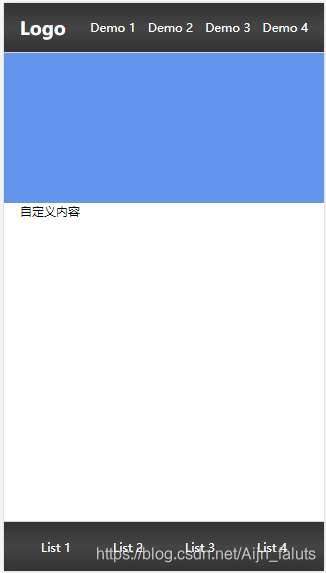flex是对于页面一个非常重要的样式,不会用到px来布局,用rem来代替
rem是根据根文档,也就是html标签上的字体大小来运算的1rem=16px;
手机端的布局也很简单,掌握好flex所有的属性和rem写页面就是一件很轻松的事。
flex的知识过多,咱们只说能应用到的:
HTML
<!DOCTYPE html>
<html lang="zh">
<head>
<meta charset="UTF-8" />
<meta name="viewport" content="width=device-width, initial-scale=1.0" />
<meta http-equiv="X-UA-Compatible" content="ie=edge" />
<link rel="stylesheet" type="text/css" href="new_file.css" />
<title>flexPhone</title>
</head>
<body>
<div class="container">
<div class="nav">
<div class="nav-header">Logo</div>
<!--商标-->
<ul class="nav-right">
<li>Demo 1</li>
<li>Demo 2</li>
<li>Demo 3</li>
<li>Demo 4</li>
</ul>
</div>
<!--导航-->
<div class="Pagebody">
<div class="banner"></div>
<!--banner图-->
<div class="main">
</div>
<!--主体内容-->
</div>
<!--主体部分-->
<div class="footer">
<div class="footer-list">List 1</div>
<div class="footer-list">List 2</div>
<div class="footer-list">List 3</div>
<div class="footer-list">List 4</div>
</div>
<!--底部选框-->
</div>
</body>
</html>
CSS
* {
margin: 0;
padding: 0;
list-style: none;
}
html,
body,
.container {
width: 100%;
height: 100%;
font-size: 100px;
}
.container {
font-size: 0.12rem !important;
display: flex;
flex-direction: column;
}
.nav {
top: 0;
border-bottom: 0.01rem solid lightgray;
}
.nav,
.footer {
background: linear-gradient(to bottom, #333, #444, #333);
color: white;
position: fixed;
width: 100%;
height: 0.5rem;
box-sizing: border-box;
padding: .16rem 0.16rem;
}
.footer {
border-top: 0.01rem solid lightgray;
bottom: 0;
display: flex;
align-items: center;
justify-content: space-around;
}
.nav .nav-header {
font-weight: bold;
color: #fff;
line-height: 100%;
font-size: 0.18rem;
float: left;
}
.nav .nav-right {
float: right;
}
.nav .nav-right li {
float: left;
margin-left: 0.12rem;
}
.Pagebody {
flex:1;
padding-top: 0.5rem;
}
.banner {
width: 100%;
height: 1.5rem;
background: cornflowerblue;
}
.main{
box-sizing: border-box;
height: auto;
padding:0 0.16rem;
}
效果演示

书写时注意↓
- meta标签
<meta name="viewport" content="width=device-width, initial-scale=1.0" />
<meta http-equiv="X-UA-Compatible" content="ie=edge" />
这是在移动端布局时必须有的标签,意思是能让用户缩放屏幕的大小,页面宽度=设备宽度,我在这里用的设备型号是iPhone5的屏幕
-
html和body及自定义一个盒子来包裹页面,即 .container
这里把html的字体设为100px,那么rem就与px成了百倍的关系;即,1rem=100px -
涉及到的flex
display: flex; /*显示方式设置为flex*/
flex-direction: column; /*显示方向为 纵向*/
flex:1; /*分配为1份,加入有两个pagebody每个就占总高的1/2*/
align-items: center; /*设置轴线上子元素 为 居中*/
justify-content: space-around; /*排列方式 为 平均分配 且 两端留有空余*/